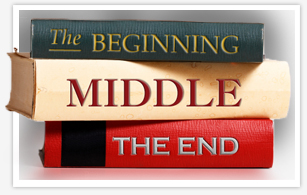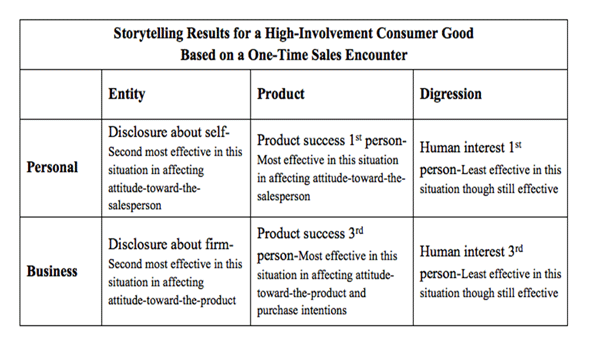The Power of Storytelling
David A. Gilliam, PhD and Alex R. Zablah, PhD

Salespeople constantly seek ways to communicate persuasively. Storytelling is a type of communication that you and I use every day. It is so common you may not even think about it when telling or hearing a story. Stories are such an important part of the fabric of human communications that failing to use them effectively in sales can be a serious handicap. That's because stories are not only an enjoyable form of communication but they are also highly credible.
In this research we examined how storytelling can affect sales encounters. After discussions with buyers and sellers we developed a framework of storytelling made up of six different types of stories. We hypothesized that these story types would have different effects on attitudes toward salespeople and attitudes toward products and that this would in turn affect purchase intentions. We then conducted experiments to test these hypotheses. In this article we first discuss what it is about stories that make them so unique as a form of communication. We then outline the framework of storytelling and discuss how the results of our experiments may impact the sales context for real estate.
What are Stories?
We first must agree on a definition for story. While some people may define this concept differently, it is important to have a concrete definition for research purposes. We used the definition: a story is a discourse dealing with interrelated actions and consequences in chronological order (Bruner 1986). It is linear ordering which gives stories much of their power as we infer causality. We found that unlike most management stories, sales stories are typically short and customized for the occasion. A sales story could be as simple as, "A few years ago our electronics were susceptible to damage by shock, but we teamed up with a manufacturer of military electronics to create our latest model. Now we have the toughest electronics in the business." You can easily follow the beginning-middle-end causality of this brief story and see how it lends credibility to the claim by telling exactly why the end result occurred.
Psychologists attribute great significance to stories. Development of ideas about who we are, who others are, how the environment around us works, and our role in that environment are often learned and retained in the form of stories or narratives. This is in part due to the critical role stories play in memory with some psychologists going so far as to say that memories are stories (Schank 1990). Think of a young child you know and consider whether this individual can understand and tell a story. From the time most humans are three years old they use story grammar to understand and learn vicariously from others about the world around them. Humans use the gist distilled from these stories to form frameworks of how the world around them works.
Stories also gain credibility from the mental processes we use to understand them. Arguments or lists of facts are processed logically so that one questionable fact casts doubt on the entire conclusion. Stories, on the other hand, are narratively processed (Gerrig 1993, 1994). Our minds distill the most important facts from the story, discard incongruent aspects, and form the most plausible gist for use in retention. Stories thus allow us to interpret and cope with the messy and confusing world around us in a way that arguments cannot (Adaval and Wyer 1998).
How Might Stories Differ?
Our research required a classification framework for the different types of stories used in sales. In interviews and observations of buyers and sellers several important aspects of stories came to the fore. Salespeople were observed to use three main topic areas: stories about the entity, i.e. the salesperson or the firm; stories about the product or service; and digressions, i.e. stories about non-sales topics. These topics became one aspect of the framework
It was also noted during the research that while salespeople believed the personal part of the relationship was critically important, buyers often felt that the business part of the relationship was central to the exchange. From the humanities we know that besides topic, point of view is an important aspect of storytelling. Thus, the other part of the storytelling framework was based on whether the story was told from a personal or business point of view. This table shows the framework where each cell represents one of six story types:
Storytelling Framework Organized by Topic and Point-of-View
*click image to enlarge/shrink*
What Did We Test?
We used this framework to develop hypotheses about the effects these story types might have on attitudes and purchase intentions. One example of such a hypothesis is:
Personal stories that make a disclosure about the salesperson will have a greater positive effect on the consumer's attitude-toward- the-salesperson than business stories that make a disclosure about the firm.
We also hypothesized that the degree of desire for a relationship with the salesperson would moderate these effects, i.e. a high-relationship orientation on the part of the customer would cause a preference for personal stories while low-relationship orientation would prompt a person to value business stories. Finally, we hypothesized that improved attitude-toward-the-salesperson and attitude-toward-the-product would increase customers' purchase intentions.
How Did We Test Our Hypotheses?
There were 427 upperclassmen students who participated in the experiment, which took place at a major university in the south-central United States. Short videos of a sales pitch for a cell phone were made using an actor and film studio. The videos were identical except the story embedded in each pitch reflected one of the six story types. The videos were used as the manipulation in carefully controlled experiments. Students were randomly assigned to view one of the six videos. Then they answered questions about their attitude-toward-the-salesperson, attitude-toward-the-cell-phone, and their purchase intentions. A variety of statistical procedures were used to analyze the students' answers (e.g., multiple analysis of covariance (MANCOVA), analysis of variance (ANOVA), regression analysis, and confirmatory factor analysis).
What Did We Learn?
Though the personal versus business stories differed only in the use of first-person versus third-person pronouns, sensitive analytical techniques revealed that personal stories did have a greater effect on attitude-toward-the-salesperson than they did on attitude-toward-the-product. Conversely, business stories had a greater effect on attitude-toward-the-product than on attitude-toward-the-salesperson. The relationship-orientation of the customer did not seem to impact (or moderate) these effects.
A further study was undertaken to analyze the effect of story topic. Remember that the three topics were entity, product, or digressions. The results indicated that stories about the entity had a greater effect on attitude-toward-the-salesperson than attitude-toward-the-product. Conversely, stories on the product topic had a greater impact on attitude-toward-the-product than attitude-toward-the-salesperson. In general, digression stories had the least impact on attitudes. So, for these one-time sales pitches for a high involvement consumer good, product stories were the most effective followed by entity stories with digression stories proving least useful.
As far as attitudes' effect on purchase intentions, in these one-shot sales encounters attitude-toward-the-product was a more important determinant than attitude-toward-the-salesperson. Clearly, stories on the product topic were preferable. It is important to note that since stories from a business point of view affect attitude-toward-the-product more strongly, they are also to be preferred in this setting.
Conclusion
Humans find plausible stories very persuasive and credible largely due to their revelation of causality and narrative-based processing. Our proposed framework for storytelling outlines a simple way to classify sales stories. After testing the effects of the different story types in a sales setting, we consider how the findings may be useful in a real estate sales setting.
Stories will have an effect on your clients' attitudes which will in turn have an effect on their purchase process and outcomes. While our experiments represent a single sales encounter and multi-encounter sales settings may be somewhat different, it is quite reasonable to expect these fundamental findings to hold true through the sales process.
Stories about the real estate being considered and stories about real estate in general have a greater impact on attitude-toward-real-estate and on purchase intentions in the process. Keep in mind that all story types impacted all attitudes and purchase intentions, but the effects were greater on particular attitudes. Sales efforts like real estate that require multiple encounters might exhibit an increased importance of attitude-toward-the-agent or salesperson. Even if other types of stories surpassed real estate stories, the findings indicate strongly that these types of stories would continue to be very useful.

Stories about you and your agency appear to impact attitudes toward you (as the salesperson). This effect might be relatively more powerful in multi-encounter sales situations.
Finally, digressions (or unrelated stories) did impact attitudes and intentions but in this one-shot encounter they were significantly less effective than other types of stories. How this might change in a multi-encounter setting remains an open question but it seems likely that they can be part of an effective storytelling toolkit. We have summarized these results in this table:
In characterizing the overall findings we may say that product topic and business point-of-view stories proved to be effective sales tools and should be a commonly used part of any salesperson's repertoire. Entity topic and personal point-of-view stories should also prove effective, and this may be even more true in multi-encounter sales. Until more is known it may be best to rely less on stories that are digressions from the transaction at hand, though there is no reason to avoid them entirely in multi-encounter sales efforts.
Storytelling Results for a High-Involvement Consumer Good Based on a One-Time Sales Encounter
*click image to enlarge/shrink*
. . . . . . . . . . . . . . . . . . .
Recommended Reading
Gilliam, David A. & Alex R. Zablah (2013), "Storytelling During Retail Sales Encounters," Journal of Retailing & Consumer Services, 20, 488-94.
. . . . . . . . . . . . . . . . . . .
References
Adaval, R. & R.S. Wyer, Jr. (1998), "The Role of Narratives in Consumer Information Processing," Journal of Consumer Psychology, 7, 207-45.
Bruner, J. (1986), Actual Minds, Possible Worlds, Cambridge, MA: Harvard University Press.
Gerrig, R. J. (1993), Experiencing Narrative Worlds, New Haven: Yale University Press.
Gerrig, R. J. (1994), "Narrative Thought?" Personality & Social Psychology Bulletin, 20, 712-15.
Schank, R. C. (1990), Tell Me a Story, New York: Charles Scribner's Sons.
. . . . . . . . . . . . . . . . . . .
About the Authors
David A. Gilliam, PhD
Assistant Professor of Marketing and Assistant Director of the Center for Professional Selling, University of Arkansas at Little Rock
David A. Gilliam is Assistant Professor of Marketing and Assistant Director of the Center for Professional Selling at the University of Arkansas at Little Rock. David received a Ph.D. from the Spears School of Business, Oklahoma State University (2011) and holds an M.B.A. from Wright State University and a B.A. (Economics) summa cum laude from Ohio University. Prior to graduate school, he spent four years as a field representative for Heidelberg Eastern Incorporated, Division of East Asiatic Corporation, Copenhagen, Denmark, and most recently seventeen years in an Ohio based entrepreneurial venture in the graphic arts machinery industry. His work has appeared or is forthcoming in the European Journal of Marketing, Journal of Retailing and Consumer Services, International Review of Retail Distribution and Consumer Research, Industrial Marketing Management, and a number of conference proceedings. His research focuses on boundary spanner issues for salespeople and service workers, especially those regarding communication and relationships. He has taught MBA core and electives, sales management, professional selling, strategy, services, retailing, principles, and consumer behavior. He is a member of the American Marketing Association.
Alex R. Zablah, PhD
Associate Professor of Marketing, University of Tennessee at Knoxville
Alex R. Zablah obtained his Ph.D. in Business Administration from Georgia State University. He is currently an Associate Professor in the Department of Marketing and Supply Chain Management at the University of Tennessee, Knoxville. His research examines issues of practical importance at the customer-employee interface in both sales and service contexts. He has complementary research interests in the area of multilevel theory and methods. His research has been published in leading journals across business disciplines, including the Journal of Marketing, Journal of Applied Psychology, and Information Systems Research, as well as in other marketing management and specialty area journals. Alex has taught a variety of courses at the undergraduate, MBA, Executive MBA and doctoral level, both in person and using distance technologies. Alex has received multiple awards in recognition of his research and teaching efforts.

